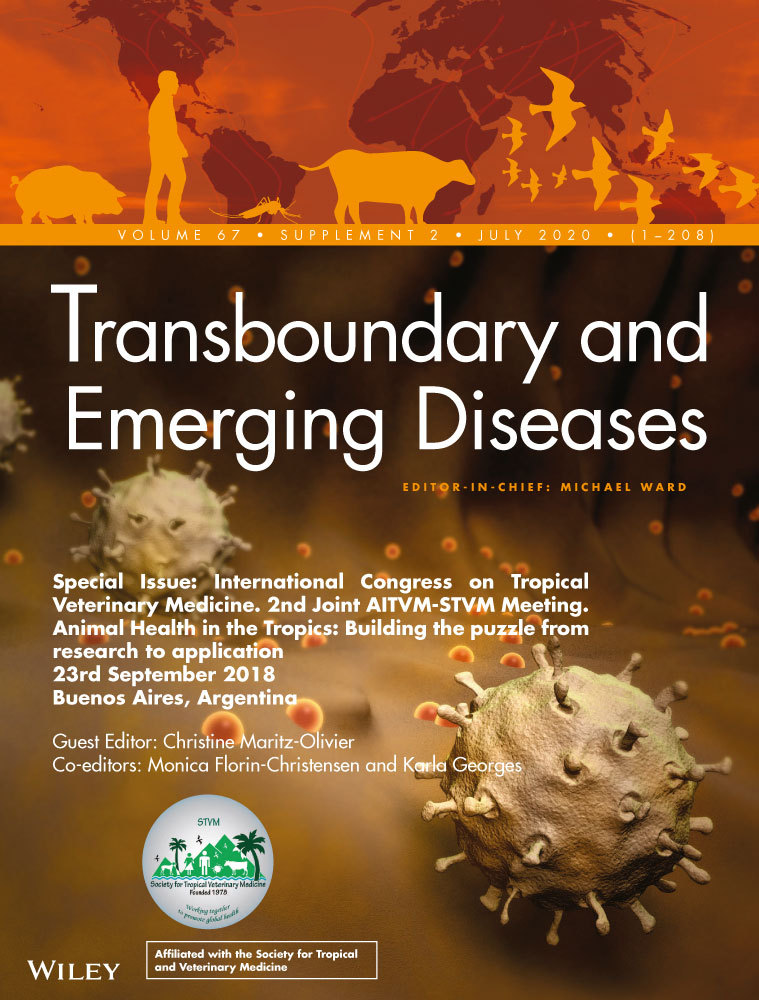Ver ítem
- xmlui.general.dspace_homeCentros e Institutos de InvestigaciónCICVyA. Centro de Investigación en Ciencias Veterinarias y AgronómicasInstituto de PatobiologíaArtículos científicosxmlui.ArtifactBrowser.ItemViewer.trail
- Inicio
- Centros e Institutos de Investigación
- CICVyA. Centro de Investigación en Ciencias Veterinarias y Agronómicas
- Instituto de Patobiología
- Artículos científicos
- Ver ítem
High genetic diversity and differentiation of the babesia ovis population in Turkey
Resumen
Babesia ovis is a tick‐transmitted protozoan haemoparasite causing ovine babesiosis in sheep and goats leading to considerable economic loss in Turkey and neighbouring countries. There are no vaccines available, therapeutic drugs leave toxic residues in meat and milk, and tick vector control entails environmental risks. A panel of eight mini‐ and micro‐satellite marker loci was developed and applied to study genetic diversity and substructuring of B. ovis
[ver mas...]
Babesia ovis is a tick‐transmitted protozoan haemoparasite causing ovine babesiosis in sheep and goats leading to considerable economic loss in Turkey and neighbouring countries. There are no vaccines available, therapeutic drugs leave toxic residues in meat and milk, and tick vector control entails environmental risks. A panel of eight mini‐ and micro‐satellite marker loci was developed and applied to study genetic diversity and substructuring of B. ovis from western, central and eastern Turkey. A high genetic diversity (He = 0.799) was found for the sample of overall B. ovis population (n = 107) analyzed. Principle component analysis (PCoA) revealed the existence of three parasite subpopulations: (a) a small subpopulation of isolates from Aydin, western Turkey; (b) a second cluster predominantly generated by isolates from western Turkey; and (c) a third cluster predominantly formed by isolates from central and eastern Turkey. Two B. ovis isolates from Israel included in the analysis clustered with isolates from central and eastern Turkey. This finding strongly suggests substructuring of a major Turkish population into western versus central–eastern subpopulations, while the additional smaller B. ovis population found in Aydin could have been introduced, more recently, to Turkey. STRUCTURE analysis suggests a limited exchange of parasite strains between the western and the central–eastern regions and vice versa, possibly due to limited trading of sheep. Importantly, evidence for recombinant genotypes was obtained in regionally interchanged parasite isolates. Important climatic differences between the western and the central/eastern region, with average yearly temperatures of 21°C versus 15°C, correspond with the identified geographical substructuring. We hypothesize that the different climatic conditions may result in variation in the activity of subpopulations of Rhipicephalus spp. tick vectors, which, in turn, could selectively maintain and transmit different parasite populations. These findings may have important implications for vaccine development and the spread of drug resistance.
[Cerrar]

Autor
Mira, Anabela;
Unlu, Ahmet Hakan;
Bilgic, Huseyin Bilgin;
Bakirci, Serkan;
Hacilarlioglu, Selin;
Karagenc, Tulin;
Carletti, Tamara;
Weir, William;
Shiels, Brian;
Shkap, Varda;
Aktas, Munir;
Florin‐Christensen, Mónica;
Schnittger, Leonhard;
Fuente
Transboundary and Emerging Diseases 67 (Supl. 2) : 26-35 (Julio 2020)
Fecha
2020-07
Editorial
Wiley
ISSN
1865-1674
Documentos Relacionados
Formato
pdf
Tipo de documento
artículo
Proyectos
(ver más)
INTA/PNBIO/1131034/AR./Inmunología molecular y genómica funcional aplicadas a interacciones patógeno hospedador de interés pecuario.
Palabras Claves
Derechos de acceso
Abierto
 Excepto donde se diga explicitamente, este item se publica bajo la siguiente descripción: Creative Commons Attribution-NonCommercial-ShareAlike 2.5 Unported (CC BY-NC-SA 2.5)
Excepto donde se diga explicitamente, este item se publica bajo la siguiente descripción: Creative Commons Attribution-NonCommercial-ShareAlike 2.5 Unported (CC BY-NC-SA 2.5)


